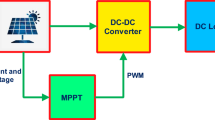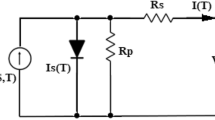Abstract
This paper focuses on IOT based soft switching boost converter based solar energy applications for smart cities and making cities smarter and greener around the globe. It presents one of the applications of the Internet of Things to design and implementation of a highly efficient boost converter used for powering the Arduino and the Bluetooth device for controlling the switching of the led and buzzer by using smart city applications. The soft switching boost converter is essential to maximize the low-level voltage obtained from the solar board to the enhanced voltage conversion ratio for the efficient electric power generation. In this paper, the three separate methodologies of DC–DC boost converters with additional resonant/snubber circuit and resistive load associated with solar panel modules proposed with maximum power point tracking (MPPT) control. The MPPT is obtained by modified augmented perturb and observe algorithm. IoT helps Smart City(SC) systems to support various network functions throughout the generation, transmission, distribution and consumption of energy by incorporating IoT devices (such as sensors, actuators and smart meters), as well as by providing the connectivity, automation and tracking for such devices. It is utilized to extract the most extreme power from solar panel by controlling the duty ratio of the suggested soft switching based boost converter. In this paper a smart IOT system is used to control and monitoring the effect of reference power variations, parameter values to the voltage control to the converter. The solar panel, boost converter and the MPPT is modeled using MATLAB/SIMULINK environment and reach the power transfer efficiency up to 97%.
























Similar content being viewed by others
References
George, C. K., & Antonio, T. A. (2013). Non-linear voltage regulator design for DC/DC boost converters used in photovoltaic applications: Analysis and experimental results. IET Renewable Power Generation, 7(3), 296–308.
Ishaque, K., Salam, Z., & Syafaruddin, (2011). A comprehensive MATLAB Simulink PV system simulator with partial shading capability based on the two-diode model. Solar Energy, 85(9), 2217–2227.
Bennett, T., Zilouchian, A., & Messenger, R. (2012). Photovoltaic model and converter topology considerations for MPPT purposes. Solar Energy, 86(7), 2029–2040.
Jaber, A. A. Q., Jiang, Y., & Orabi, M. (2014). Mppt control and architecture for pv solar panel with sub-module integrated converters. Journal of Power Electronics, 14(6), 1281–1292.
Kamarzaman, N. A., & Tan, C. W. (2014). A comprehensive review of maximum power point tracking algorithms for photovoltaic systems. Renewable and Sustainable Energy Reviews, 37, 585–598.
Mohamed, A. E., Mohamed, A. F., & Nasr, A. (2016). Modeling and evaluation of main maximum power point tracking algorithms for photovoltaics systems. Renewable and Sustainable Energy Reviews, 58, 1578–1586.
Rezk, H., & Ali, M. E. (2015). A comprehensive comparison of different MPPT techniques for photovoltaic systems. Solar Energy, 112, 1–11.
Ozcelik, M. A., & Yilmaz, A. S. (2015). Improving the performance of MPPT in PV systems by modified Perturb-and-Observe algorithm. Journal of Engineering Research, 3(3), 77–96.
Mukti, R. J., & Islam, A. (2015). Modeling and performance analysis of pv module with maximum power point tracking in matlab/simulink. Applied Solar Energy, 51(4), 245–252.
Taghvaee, M. H., Radzi, M. A. M., Moosavain, S. M., Hizam, H., & Marhaban, M. H. (2013). A current and future study on non-isolated DC–DC converters for photovoltaic applications. Renewable and Sustainable Energy Reviews, 17, 216–227.
Kulkarni, A., & John, V. (2016). HF Transformer based grid-connected inverter topology for photovoltaic systems. IETE Technical Review, 33(1), 69–75.
Islam, M., Mekhilef, S., & Hasan, M. (2015). Single phase transformerless inverter topologies for grid-tied photovoltaic system: A review. Renewable and Sustainable Energy Reviews, 45, 69–86.
Patrao, I., Figueres, E., Gonzalez-Espin, F., & Garcera, G. (2011). Transformerless topologies for grid-connected single-phase photovoltaic inverters. Renewable and Sustainable Energy Reviews, 15(7), 3423–3431.
Yang, Y., & Blaabjerg, F. (2015). Overview of single-phase grid-connected photovoltaic systems. Electric Power Components and Systems, 43(12), 1352–1363.
Du, Y., & Lu, D. D. (2012). Battery-integrated boost converter utilizing distributed MPPT configuration for photovoltaic systems. Solar Energy, 85(9), 1992–2002.
Tseng, S., & Tsai, C. (2012). Photovoltaic power system with an interleaving boost converter for battery charger applications. International Journal of Photoenergy. Article ID 936843, 1–15.
Tseng, S., & Wang, H. (2013). A photovoltaic power system using a high step-up converter for dc load applications. Energies, 6(2), 1068–1100.
Abusorrah, A., Al-Hindawi, M. M., Al-Turki, Y., Mandal, K., Giaouris, D., Banerjee, S., et al. (2013). Stability of a boost converter fed from photovoltaic source. Solar Energy., 98, 458–471.
Freitas, A. A. A., Tofoli, F. L., Junior, E. M. S., Daher, S., & Antunes, F. L. M. (2015). High-voltage gain DC–DC boost converter with coupled inductors for photovoltaic systems. IET Power Electronics, 8(10), 1885–1892.
Sundar, G., Karthick, N., & Reddy, S. R. (2014). High step–up DC–DC converter for ac photovoltaic module with mppt control. Journal of Electrical Engineering, 65(4), 248–253.
Chen, H., & Lin, W. (2014). Mppt and voltage balancing control with sensing only inductor current for photovoltaic-fed, three-level, boost-type converters. IEEE Transactions on Power Electronics, 29(1), 29–35.
Choi, W., & Lee, C. (2012). Photovoltaic panel integrated power conditioning system using a high efficiency step-up DC–DC converter. Renewable Energy, 41, 227–234.
Abdi, B., Safaei, A., Moghani, J. S., & Abyaneh, H. A. (2013). An overview to soft-switching boost converters for photovoltaic. International Journal of Computer and Electrical Engineering, 5(1), 18–21.
Author information
Authors and Affiliations
Corresponding author
Rights and permissions
About this article
Cite this article
Banu, J.B., Moses, M.B. IOT Based Augmented Perturb-and-Observe Soft Switching Boost Converters for Photovoltaic Power Systems in Smart Cities. Wireless Pers Commun 102, 2619–2641 (2018). https://doi.org/10.1007/s11277-018-5280-x
Published:
Issue Date:
DOI: https://doi.org/10.1007/s11277-018-5280-x




